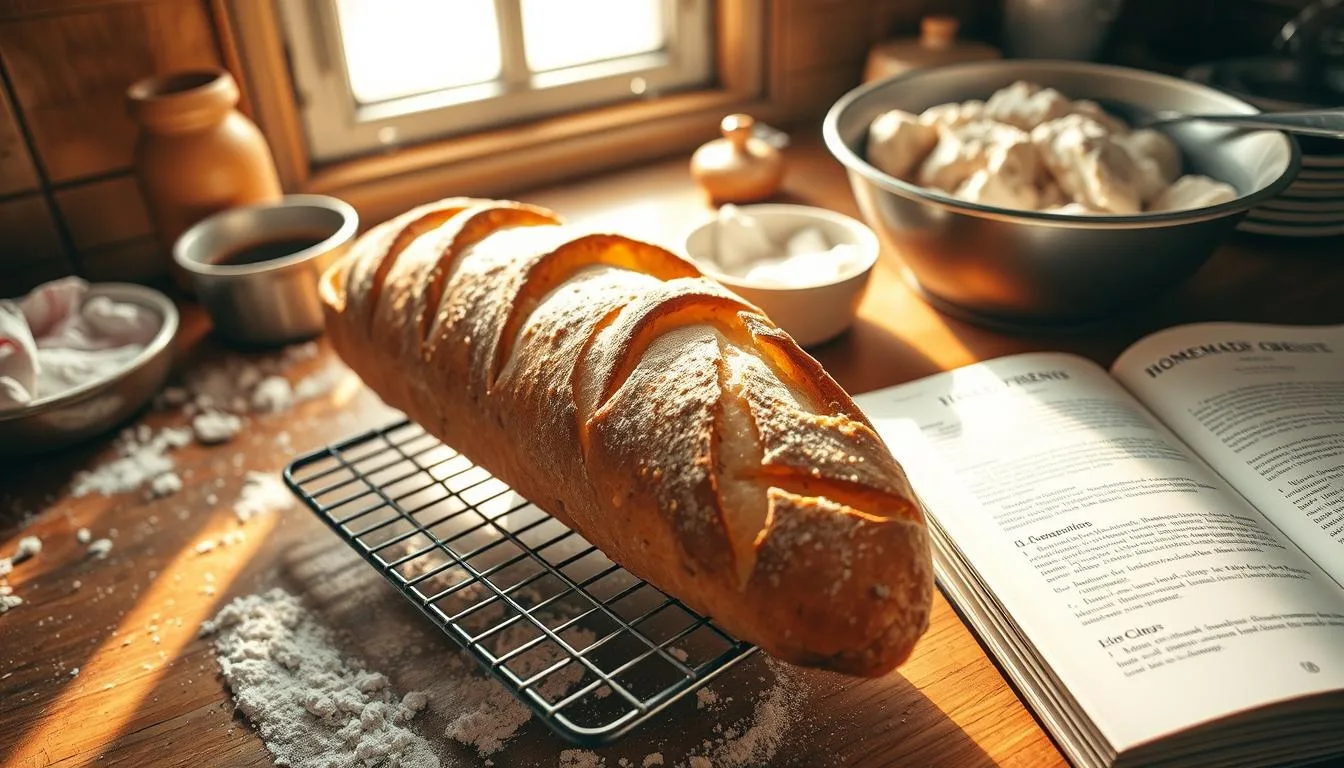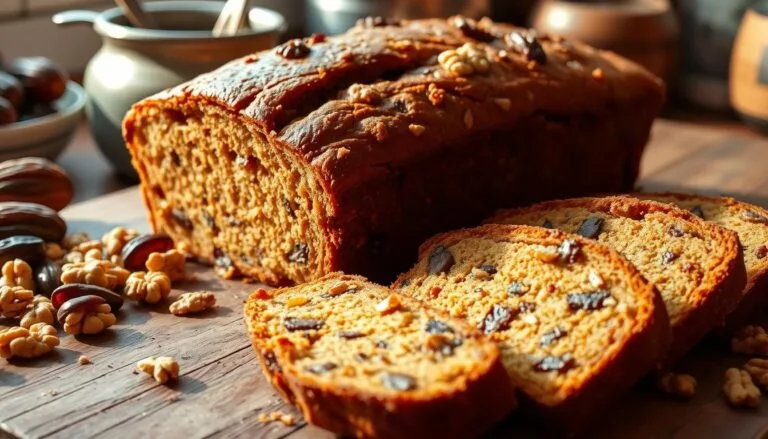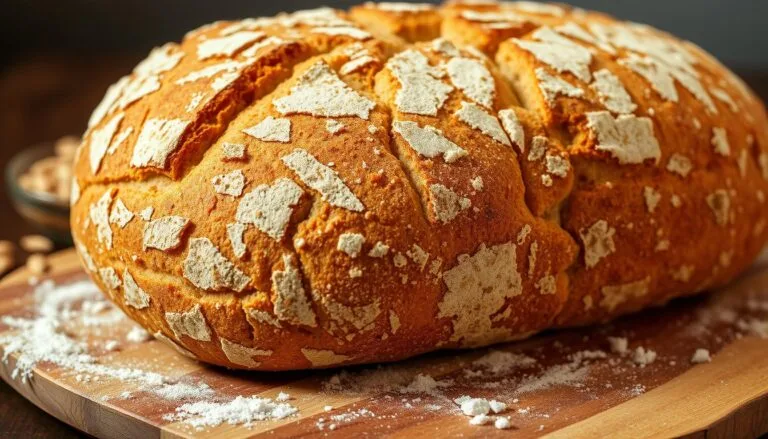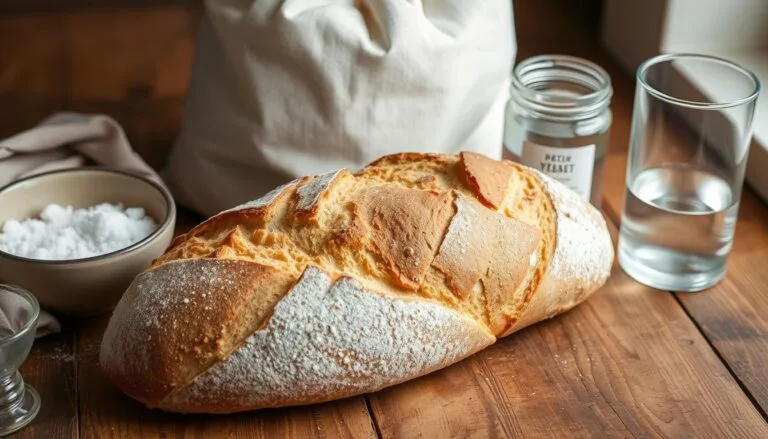How to Make the Easiest French Baguette
Imagine biting into a warm, crusty french baguette. The soft inside and sweet taste are amazing. You can make this authentic baguette at home with just four ingredients and no kneading. This recipe makes 2-6 baguettes, depending on size, and is quick to prepare.
To start, you need 6 cups of flour, 3 cups of lukewarm water, 2 teaspoons of yeast, and 2 teaspoons of salt. The dough rests for 12-20 hours before shaping. This lets the yeast work its magic. Then, it rises for 1-2 hours in a warm spot, and you’re almost done.
As you make this easy french baguette, remember that practice is key. Your first try might not be perfect, but don’t worry. With patience and this recipe, you’ll soon enjoy a delicious, homemade french baguette. It will be a great addition to your baking collection.
Table of Contents
Understanding the French Baguette
Starting to make your own baguette recipe is exciting. It’s important to know the history and value of the traditional French baguette. It was added to the UNESCO World Heritage List, showing its cultural importance. You can make a tasty baguette in about 2 hours, including prep and cooking time.
Creating a perfect baguette requires the right ingredients and techniques. French baguettes are made from flour, water, yeast, and salt. Using top-quality ingredients and a proven method is key. Choosing a natural yeast starter or high-quality instant yeast improves the baguette’s taste and texture.
Many think making a baguette is hard because of complex ingredients or tools. But, a simple recipe can yield a delicious baguette. Here are some tips to help you:
- Choose a good flour, like bread flour or all-purpose flour
- Use the right amount of yeast, about 8 grams of dry active yeast
- Combine water and salt for the perfect dough consistency
By following these tips and a reliable recipe, you can make a great French baguette . It’s a fun and rewarding process, perfect for beginners or experienced bakers.
Essential Ingredients for Your French Baguette Recipe
To make a delicious French baguette recipe, you need flour, yeast, salt, and water. The french bread recipe calls for 2 1/2 cups of all-purpose flour, 1 tablespoon of sugar, 1 1/2 teaspoons of instant dry yeast, and 1 cup of warm water. The king arthur no-knead baguette might have slightly different ingredients, but the basics are the same.
Here are the key ingredients you will need:
- 2 1/2 cups of all-purpose flour
- 1 tablespoon of sugar
- 1 1/2 teaspoons of instant dry yeast
- 1 cup of warm water
- Salt, to taste
For ano knead french bread, use similar ingredients. Focus on high-quality flour and yeast for rising. By following a simplefrench bread recipe, you can make a delicious French baguette at home.

Remember to measure your ingredients carefully. Mix them together in the right proportions for the best results. With practice and patience, you can master making French baguettes using a king arthur no-knead baguette or no knead french bread recipe.
Required Equipment and Tools
To make a tasty French baguette, like a sourdough, you’ll need some key tools. A pastry scale, spatula, and big mixing bowl are must-haves for measuring and mixing. A dutch oven can also help make your baguette’s crust crispy.
For basic kitchen tools, you’ll need a few simple items. These include:
- A large mixing bowl
- A measuring cup and spoons
- A wooden spoon or spatula
- A pastry scale
If you want to improve your baguette-making skills, consider these professional tools. A dough scraper, bench scraper, and a lame or razor blade for scoring are useful. For a mini baguette, use a smaller bowl and a mini dutch oven.
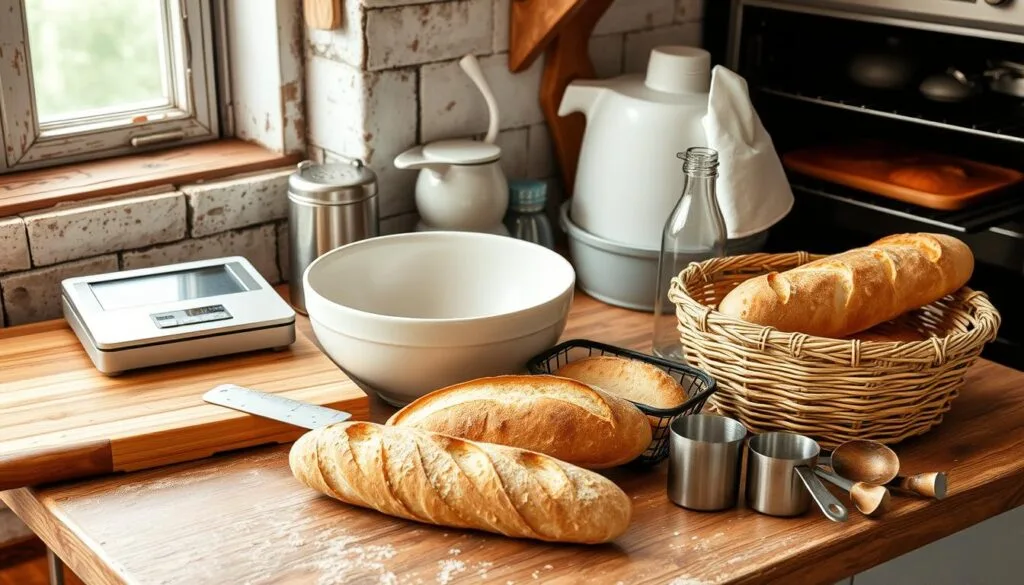
Remember, the secret to a great French baguette is quality ingredients and careful dough mixing and fermentation. With the right tools, you can make a delicious sourdough baguette at home.
Mastering the Perfect Dough Consistency
To make a tasty homemade baguette, you must get the dough right. This is key in a quick baguette recipe. A classic baguette recipe calls for a wet, sticky dough. It’s tricky, but with the right methods, you can nail it.
When mixing and kneading, aim for a dough that’s moist and sticky. Use a artisan baguette recipe as a guide. But remember, the dough’s consistency is what makes it great. Here are some tips to help you get it just right:
- Start with the right amount of water: The water needed depends on your climate and flour type. Begin with a little and add more as needed.
- Knead for 5-7 minutes: This helps develop the gluten for the perfect dough.
- Let the dough rest: Resting it for at least 1 hour lets the yeast work and the dough to rise.
By following these tips and techniques, you can achieve the perfect dough. Remember to be patient and avoid overworking the dough. This can make your bread dense and tough.
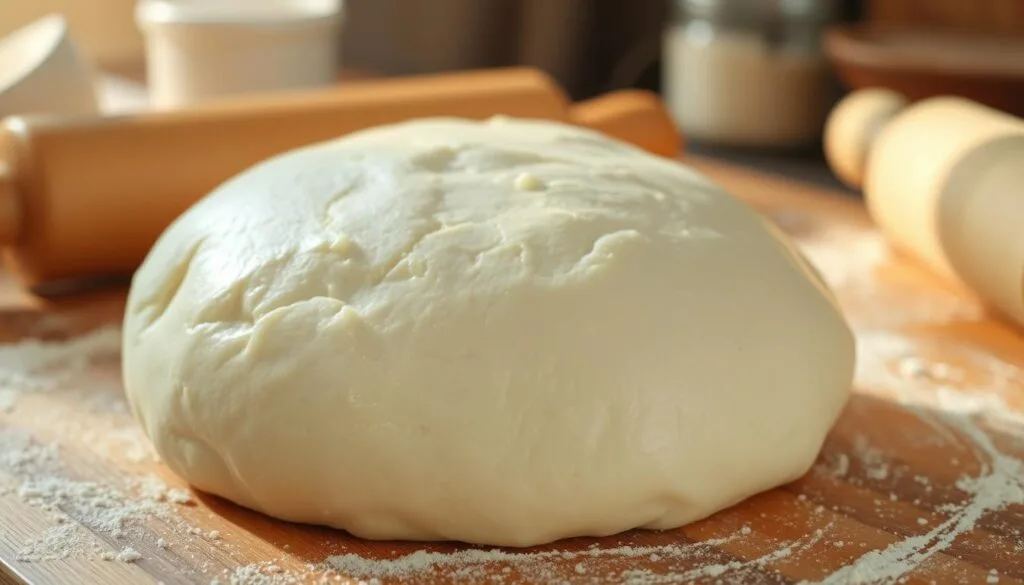
The Step-by-Step French Baguette Recipe
To make a delicious french baguette, follow a series of steps. Start by mixing ingredients like bread flour, salt, yeast, and warm water to create the dough. This recipe takes 13 hours and 45 minutes, including prep, cook, and rising times.
The first step is mixing the ingredients, which takes about 5 minutes with a dough hook. Then, the dough needs to rise for 12 to 14 hours, or until it doubles in volume. This step is key for developing the bread’s flavor and texture.
Mixing and Initial Fermentation
While rising, yeast ferments the sugars, producing carbon dioxide and making the dough rise. It’s important to let the dough rise at room temperature, away from drafts, for even fermentation.

Folding and Shaping Techniques
After rising, fold and shape the dough into its final form. Fold the dough over itself several times to develop the gluten and create a smooth texture. Then, shape it into a long, thin cylinder, the classic french baguette shape.
By following this easy baguette recipe, you can make a delicious and authentic french baguette. It’s sure to impress your friends and family.
Creating the Signature Crust
To make a crusty french baguette, score the bread and bake it in a hot oven with steam. Scoring lets the bread expand, making a beautiful, golden crust. The steam makes the crust crispy, giving your homemade baguette a pro look.
Here are some tips for the perfect crust:
- Use a sharp blade or razor to score the bread, making 2-3 diagonal cuts on the top of the loaf.
- Preheat your oven to 475 degrees F, with a cast iron skillet or baking stone inside to create steam.
- Place the scored loaf in the oven, and immediately add ½ cup of ice cubes or water to the skillet to create steam.
- Bake for 25-30 minutes, or until the crust is golden brown and the bread sounds hollow when tapped.
Follow these tips to make a stunning, crusty french baguette with a tasty, golden brown crust. Keep an eye on your loaf, as the crust can burn quickly.

With practice and patience, you’ll master making a perfect, homemade baguette with a signature crust. It will impress your friends and family.
Baking Techniques for the Perfect Golden Brown
To get the perfect golden brown crust on a baguette, you need to know the right techniques. First, make sure your oven is at 450°F. This temperature, along with the right baking time, will give you a crispy, golden crust.
For baking time, a good starting point is 25-30 minutes. But, this can change based on your oven and baguette size. Also, remember that steam is key in the first ten minutes. It helps the crust develop and the bread rise. You can make steam by covering your oven or using a pan of water.
- Using a baking stone or steel to help create a crispy crust
- Creating steam in the oven to promote oven spring and crust development
- Monitoring the bread during the baking process to ensure it doesn’t overcook
By using these techniques and tips, you’ll make a delicious baguette with a golden brown crust. This will take your baking to a new level.
Getting the perfect crust is all about experimenting. Find the right mix of temperature, time, and steam for you. With practice, you’ll make a stunning, tasty baguette that will wow everyone.
Common Problems and Solutions
When making a French baguette, you might face baguette problems like a dense or flat loaf. To fix these common baguette issues, check the yeast and adjust the baking time. Experts say instant yeast is the best for dough rising. Using cold water also helps the dough rise.
It’s also key to ensure the water is between 105°F and 115°F for proofing yeast. This temperature is crucial for the best results.
To solve baguette problems, consider these tips:
- Check the yeast activity: dead yeast, water too hot, or water too cold can affect yeast activity.
- Adjust the baking time: overproving can occur if dough is left to prove beyond 40 minutes.
- Monitor the room temperature: a temperature between 75°F and 85°F is recommended for bread rise.
By following these baguette solutions, you can overcome common challenges. Use the right flour-to-water ratio, about 2:1 by weight. Also, make sure the bread reaches an internal temperature of at least 190°F. With practice and patience, you’ll master making a delicious French baguette.
Storage and Reheating Tips
After baking your perfect French baguette, it’s key to store it right. Keep it at room temperature for up to 2 days. This keeps the crust crunchy and the inside soft. For longer storage, freeze it in a freezer-safe bag for up to 3 months.
Reheating your baguette is an art. To refresh a day-old baguette, try soaking it in water or reheat it in the oven. For oven reheating, preheat to 300°F. Bake a whole baguette for 12 minutes, or 10 minutes for halves or cuts. Then, bake for an extra 4-5 minutes to get the crust right.
Proper Storage Methods
Here are some tips for storing your baguette:
- Keep the baguette in a cool, dry place to avoid moisture.
- Don’t store it in direct sunlight or near heat.
- Use a paper bag or a breathable container, not plastic.
Refreshing Day-Old Baguettes
To make a stale baguette fresh again, try reheating it in the oven or the water-soaking method. You can also reheat it at 350°F for 10-15 minutes. Enjoy your baguette within 15-20 minutes, as it won’t last as long as fresh bread.
Serving Suggestions and Pairings
There are countless ways to serve a French baguette. You can enjoy it alone or with various dishes to boost its taste. For a classic choice, pair it with soups, salads, or cheeses. The goal is to mix flavors and textures well, so feel free to try new things.
A French baguette is great for many dishes, like po’ boy sandwiches or French onion soup. You can also make bruschetta or creamy garlic bread. The options are endless, and a bit of creativity can lead to many tasty dishes. Some favorite ways to serve a French baguette include:
- Pairing with seafood, such as shrimp or crab, for a fresh and flavorful combination
- Using it as a base for sandwiches, such as a bacon butty or a grilled cheese
- Serving it with dips, such as hummus or spinach and artichoke dip
- Creating a charcuterie board with cured meats, cheeses, and crackers
Remember, the secret to a great baguette is using top-notch ingredients and trying new things. With practice, you’ll master making delicious pairings.
Conclusion
Congratulations! You’ve learned how to make the perfect homemade French baguette. It only takes a few ingredients and basic tools to make bakery-quality baguettes at home. The steps might seem hard at first, but they’re actually easy and fun.
By using the easy baguette recipe and techniques from this guide, you’ll impress your loved ones. Feel free to try different flours, shapes, and baking times to find what you like best. Making your own French baguettes lets you tailor them to your taste.
So, what are you waiting for? Get your ingredients ready, preheat your oven, and start baking! With a bit of practice, you’ll make baguettes as good as those from a fancy bakery. Enjoy the baking, the smell, and the joy of making a French classic from scratch.
FAQ
What are the essential ingredients for making a French baguette?
What kind of equipment and tools do I need to make a French baguette?
How do I achieve the perfect dough consistency for a French baguette?
What are the steps for making a homemade French baguette?
How do I create the signature crust on a French baguette?
What are some common problems and solutions for making a French baguette?
How should I store and reheat a homemade French baguette?
What are some serving suggestions and pairings for a French baguette?
Leave a Review
There are no reviews yet. Be the first one to write one.

